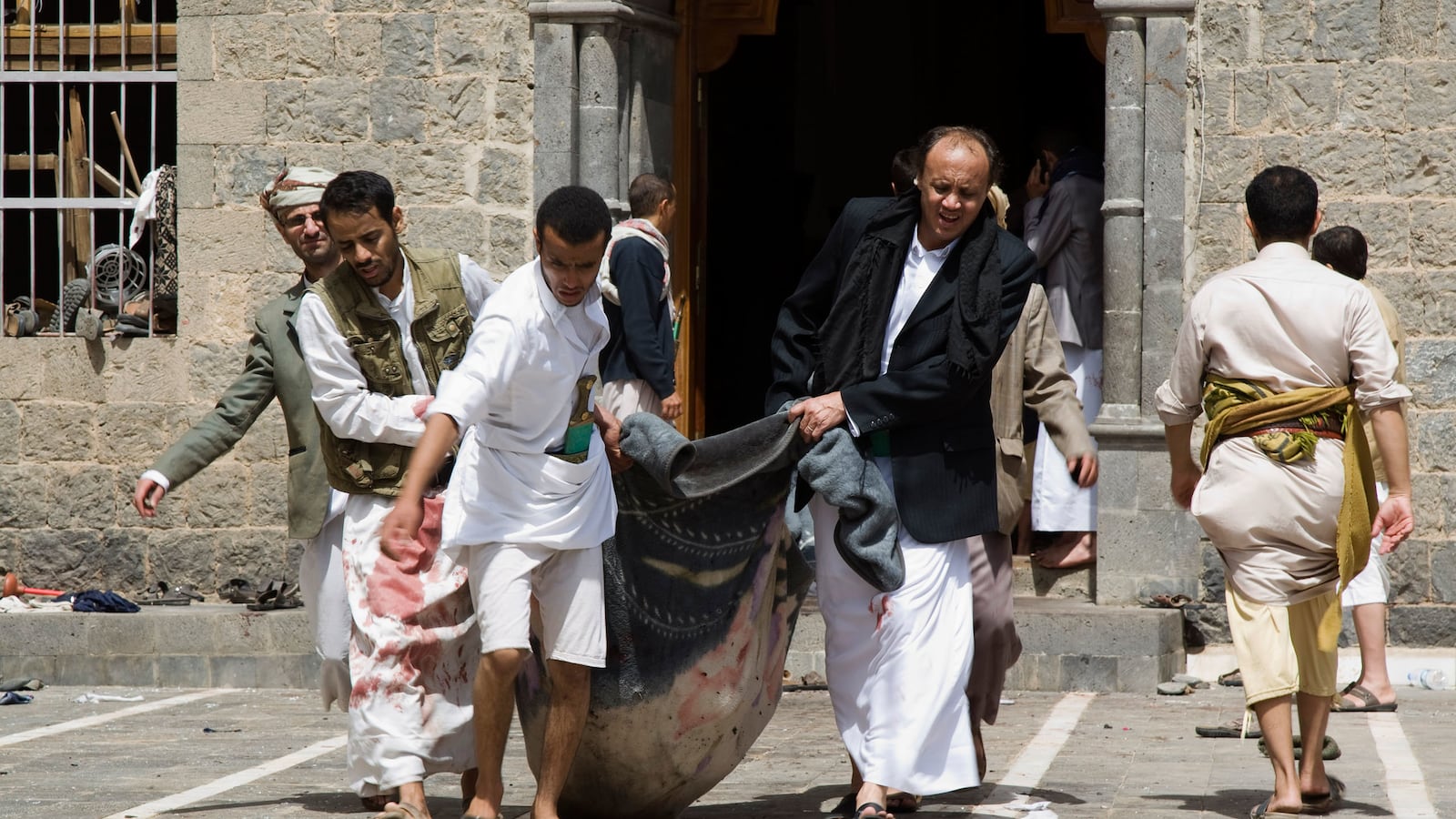ISTANBUL — Twin suicide bombings today on two Shia mosques in the heart of the Yemeni capital of Sanaa killed as many as 137 people and wounded 280 others in an attack timed to coincide with worshippers attending noon prayers. Bodies were left lying in pools of blood as the injured were rushed to hospitals.
U.S. officials at first suspected the coordinated attack was mounted by al Qaeda’s local offshoot, but it was claimed quickly by the so-called Islamic State.
The claim for responsibility was made in an online statement posted on the same website the Islamic State, widely known as ISIS, used to claim an affiliate was behind Wednesday’s deadly attack on a landmark museum in Tunis that left 20 foreign tourists dead. In the statement the bombings of the Sanaa mosques was described as a “blessed operation” against the “dens of the Shiites.”
A U.S. official cautioned that it was too soon to know definitively who is behind the attacks, which bear the hallmarks of al Qaeda-type operations using complex, coordinated attacks by multiple bombers.
The two mosques — Badr and al-Hashoosh — are used by Houthi rebels, members of the Zaidi sect, a branch of Shia Islam, and three Houthi leaders are reported among the dead. Al Qaeda and other jihadists had vowed to confront the Houthis after they overran Sanaa in September demanding a greater share of political power. The Houthis subsequently seized the presidential palace in January, forcing President Abdu Rabu Mansour Hadi, a U.S. ally, to flee.
Bombings of mosques in Yemen have been rare and some analysts warn that Friday’s attacks mark a new low in the country’s violence which could plunge Yemen into a spiral of sectarian conflict between the country’s majority Sunnis and minority Shia Muslims. If so, it will be hard to stop.
A separate explosion triggered by a suicide bomber rocked a compound in the Houthi stronghold of Saada—111 miles northeast of Sanaa—killing two people and seriously injuring a third, say local Houthi security officials. Houthi officials say another suicide bomber was prevented from attack a mosque in Saada.
Among those killed in Sanaa was a prominent Houthi religious leader, Murtatha al Mahathwari, the state-run Saba news agency reported. Yemeni politicians from Hadi administration warned that the attack was pushing Yemen closer to an all-out civil war. “Someone is trying to widen the schisms in the country and are happy to escalate the violence,” said Mohamed Qubaty, a former political advisor to the Hadi government.
The timing of the attacks in Sanaa virtually guaranteed a bloodbath, and the tactics used did too. According to witnesses a suicide bomber started the attack on the Badr mosque inside the building and that was followed minutes later by an explosion outside, presumably planned to harm those fleeing the first blasts and to strike first-responders and civilian rescuers, say senior Houthi leaders. Those tactics are straight out of al Qaeda’s playbook.
At Hashoush mosque the plan may have been the same but one of the bombers was stopped at a checkpoint outside and detonated his explosions before his companion made it inside to trigger his blast.
Before the Islamic State’s claim of credit for the carnage, Houthis also blamed al Qaeda. Others pointed the finger at the country’s ousted strongman Ali Abdullah Saleh, despite the fact that he has been implicated in the Houthis toppling of Hadi.
A worshipper at the al Hashoosh mosque, in the north of the capital, told Associated Press that he was thrown into the air by the blast. “The heads, legs and arms of the dead people were scattered on the floor of the mosque," said Mohammed al-Ansi. “Blood is running like a river,” he added. Witnesses also reported that many of those killed and wounded were struck by glass shards from the mosques’ shattered windows.
On Houthi-run al Masirah TV channel volunteers could be seen ferrying the injured using blood-soaked blankets.
Yemen has been the base of al Qaeda in the Arabian Peninsula (AQAP), which controls several provinces in the south and has carried out similarly complex suicide attacks on the Houthis before. A car bomb in January that killed 30 outside a police academy in Sanaa was blamed on the group. But the Islamic State, al Qaeda’s rival, announced the formation of a local branch last November, drawing some AQAP defections, among them possibly some bombing tacticians.
The mosque explosions came a day after fierce clashes erupted between Houthi rebels and their supporters and government forces still loyal to Hadi in the port city of Aden, nearly 200 miles southeast of Sanaa. Houthi warplanes attacked the presidential palace in Aden, where Hadi has been based since fleeing last month from Sanaa, where he had been placed under house arrest. Hadi’s downfall and the Houthis’ sweep into the Yemeni capital was a blow to U.S. counter-terror efforts. The Hadi government had cooperated with Washington to target al Qaeda operatives in drone strikes.
If ISIS was responsible for the blasts in Sanaa, it would mark, along with the attack in Tunis, a spectacular, albeit grisly, debut week on the international terror stage. In a matter of days it has killed nearly 160 people and wounded at least 300; retarded Tunisia’s economic comeback and therefore imperiled the country’s political stability; and set Yemen on a possible sectarian death spiral. Until this week, ISIS has focused on defending it’s so-called caliphate straddling Iraq and Syria. But the group’s international ambitions have been clear, encouraging al Qaeda affiliates to defect and swear allegiance to the ISIS leader Abu Bakr al Baghdadi or helping them to form new jihadist offshoots.
AQAP remains for US officials the most worrisome of all the terror network's branches, U.S. intelligence officials say. That's because the group possesses sophisticated knowledge and expertise for building bombs that can be smuggled onto commercial aircraft without being detected by security scanners.
Shane Harris in Washington contributed to this report.





